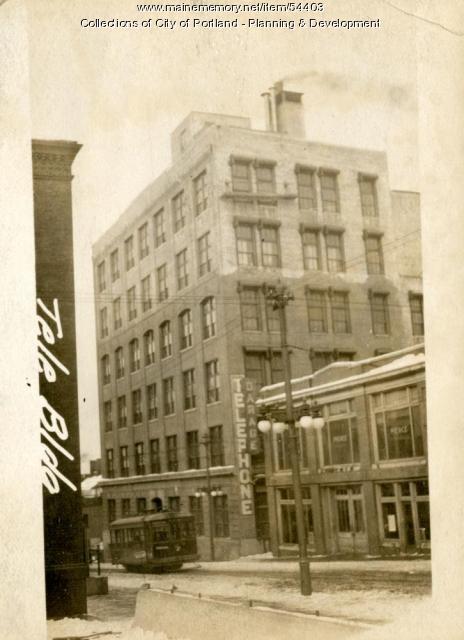Keywords: New England
Item 104938
"New England the Most Remarqueable Parts Thus Named," 1637
Contributed by: Osher Map Library and Smith Center for Cartographic Education Date: circa 1614 Media: Engraving
Item 51996
St. Francis College, Biddeford, ca. 1955
Contributed by: McArthur Public Library Date: circa 1955 Location: Biddeford Media: Postcard
Item 54058
41-47 Forest Avenue, Portland, 1924
Owner in 1924: New England Telephone Company Use: Office & Telephone Exchange
Item 54059
Assessor's Record, 41-47 Forest Avenue, Portland, 1924
Owner in 1924: New England Telephone Company Use: Office & Telephone Exchange
Item 151328
Garage and shop for New England Public Service Co., Rockland, 1927
Contributed by: Maine Historical Society Date: 1927–1930 Location: Rockland; Rockland; Rockland Client: New England Public Service Co. Architect: John Calvin Stevens and John Howard Stevens Architects
Item 151603
Church of the New Jerusalem, Portland, 1908-1945
Contributed by: Maine Historical Society Date: 1908–1945 Location: Portland; Portland Client: unknown Architect: John Calvin Stevens and John Howard Stevens Architects
Exhibit
Westbrook Seminary: Educating Women
Westbrook Seminary, built on Stevens Plain in 1831, was founded to educate young men and young women. Seminaries traditionally were a form of advanced secondary education. Westbrook Seminary served an important function in admitting women students, for whom education was less available in the early and mid nineteenth century.
Exhibit
Rum, Riot, and Reform - 1620 to 1820: New England's Great Secret
"1620 to 1820: New England's Great Secret Tavern sign, Raymond, ca. 1850Maine Historical Society The Coming of Drink to New England (1620–1820)…"
Site Page
View collections, facts, and contact information for this Contributing Partner.
Site Page
New Portland: Bridging the Past to the Future - Bridges of West New Portland
"… and ordered two cables to be made in Sheffield, England. That summer under his direction, Elder Ezra Wilson and William Witham with a crew built…"
Story
Working as a telephone operator in the 1940s
by Doris Tardy
Working as a telephone operator in 1946 was new and exciting, and challenging.
Story
Coaching in Maine and how to become a good coach
by University of New England
Dr. John Winkin speaks at sports medicine lecture, introduced by Dr. Doug Brown
Lesson Plan
Grade Level: 3-5, 6-8, 9-12
Content Area: Social Studies, Visual & Performing Arts
"In the four quarters of the globe, who reads an American book?" Englishman Sydney Smith's 1820 sneer irked Americans, especially writers such as Irving, Cooper, Hawthorne, and Maine's John Neal, until Henry Wadsworth Longfellow's resounding popularity successfully rebuffed the question. The Bowdoin educated Portland native became the America's first superstar poet, paradoxically loved especially in Britain, even memorialized at Westminster Abbey. He achieved international celebrity with about forty books or translations to his credit between 1830 and 1884, and, like superstars today, his public craved pictures of him. His publishers consequently commissioned Longfellow's portrait more often than his family, and he sat for dozens of original paintings, drawings, and photos during his lifetime, as well as sculptures. Engravers and lithographers printed replicas of the originals as book frontispiece, as illustrations for magazine or newspaper articles, and as post cards or "cabinet" cards handed out to admirers, often autographed. After the poet's death, illustrators continued commercial production of his image for new editions of his writings and coloring books or games such as "Authors," and sculptors commemorated him with busts in Longfellow Schools or full-length figures in town squares. On the simple basis of quantity, the number of reproductions of the Maine native's image arguably marks him as the country's best-known nineteenth century writer. TEACHERS can use this presentation to discuss these themes in art, history, English, or humanities classes, or to lead into the following LESSON PLANS. The plans aim for any 9-12 high school studio art class, but they can also be used in any humanities course, such as literature or history. They can be adapted readily for grades 3-8 as well by modifying instructional language, evaluation rubrics, and targeted Maine Learning Results and by selecting materials for appropriate age level.
Lesson Plan
What Remains: Learning about Maine Populations through Burial Customs
Grade Level: 6-8
Content Area: English Language Arts, Social Studies, Visual & Performing Arts
This lesson plan will give students an overview of how burial sites and gravestone material culture can assist historians and archaeologists in discovering information about people and migration over time. Students will learn how new scholarship can help to dispel harmful archaeological myths, look into the roles of religion and ethnicity in early Maine and New England immigrant and colonial settlements, and discover how to track changes in population and social values from the 1600s to early 1900s based on gravestone iconography and epitaphs.






















